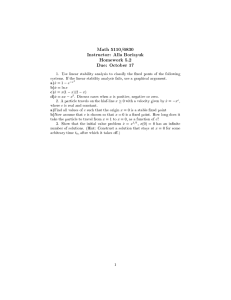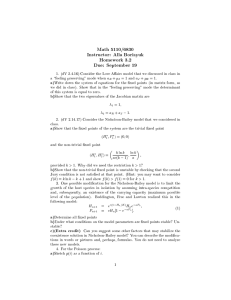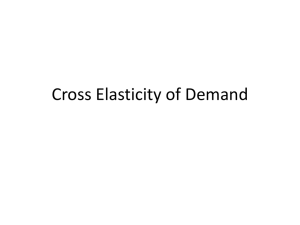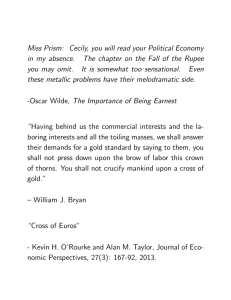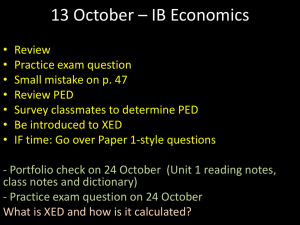Sticky-Price Exchange Rate Models Obstfeld and Rogoff, Chapter 9
advertisement
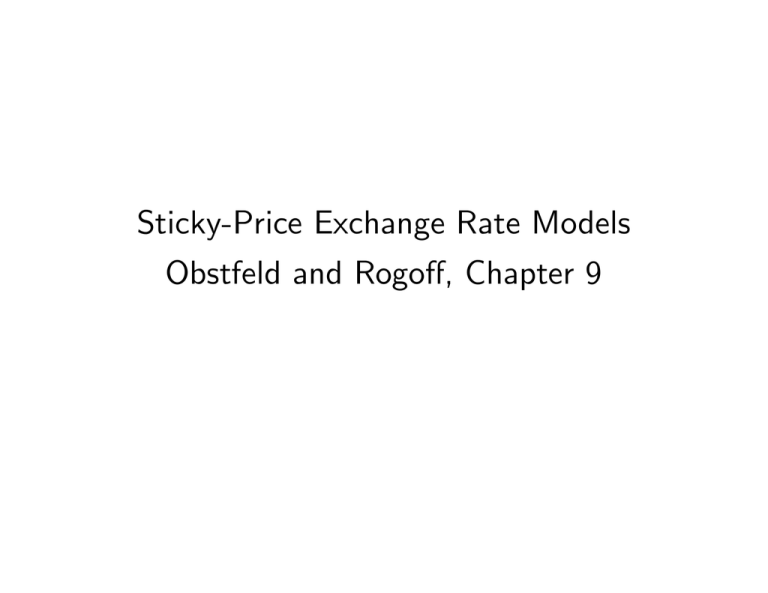
Sticky-Price Exchange Rate Models Obstfeld and Rogo¤, Chapter 9 1 Empirical Motivation for Sticky Prices Variability of the real exchange rate EP P the nominal exchange rate (E ) is very similar to variability of The real exchange rate is much more volatile over ‡oating rate periods Engel demonstrated that the relative price of similar goods between the US and Canada is much more volatile than the relative price of di¤erent goods within a country Why would a country deliberately depreciate its currency to shift demand toward their goods if prices immediately adjusted, eliminating the e¤ect? 1.1 Mundell-Fleming-Dornbusch model 1.2 Equations of the model Small letters denote logarithms with the exception of the interest rate Uncovered interest rate parity with …xed foreign interest rate it+1 = i + et+1 et Money demand mt pt = it+1 + yt Real exchange rate ‡uctuates in the short run and has a …xed long-run value (…xed foreign price level at unity implying p = 0) q = qt = et + p pt Demand is increasing in the real exchange rate relative to its long-run value ytd = y + (et + p ytd y = (qt pt q) q) Phillips Curve describing price adjustment pt+1 pt = ytd y + p~t+1 p~t – prices rise in response to excess demand and to in‡ation which would occur in full equilibrium – p~t is de…ned as the price level that would prevail if the goods market cleared p~t et + p q 1.3 Solution of the Model with Phase Diagrams Write the model as two di¤erence equations in the real and nominal exchange rates, qt and et Di¤erence equation in qt – Substitute excess demand into the Phillips Curve pt+1 pt = (qt q ) + p~t+1 p~t – Use equilibrium price to substitute for equilibrium in‡ation p~t+1 p~t = et+1 et – Substitute into the in‡ation equation pt+1 pt = (qt q ) + et+1 et – Solve for the rate of change of the real exchange rate pt+1 et+1 qt+1 (pt et) = qt = (qt (qt q) q) Di¤erence equation in et – Money demand equals money supply mt pt = it+1 + yt – Simplify by setting y=i =0 Substitute de…nition of real exchange rate for price pt = et qt Interest rate parity for the interest rate it = et+1 et And aggregate demand for output yt = (qt q) to yield money demand as mt et + qt = (et+1 et) + (qt q) – Solve for the rate of change of the nominal exchange rate et+1 et = 1 [ mt + et qt + (qt q )] Phase diagram with e on vertical axis and q on horizontal qt+1 = qt+1 et+1 = et+1 – et = 1 qt = [ mt + et (qt q) qt + (qt q )] qt+1 = 0 requires qt = q qt+1 = 0 is vertical at qt = q When qt increases, qt+1 falls @ qt+1 = @qt <0 implying that arrows of motion point towards qt+1 = 0 – et+1 = 0 requires et = mt + qt Slope of (qt q) et+1 = 0 is 1 Assume that money is constant and assume that output is not too responsive to relative price so that 1 such that the slope of When et increases, >0 et+1 = 0 is positive et+1 increases @ et+1 1 = >0 @et implying that arrows of motion point away from et+1 = 0 – System has an upward sloping saddlepath and a steady state with e=m+q Comparative Statics: Unanticipated increase in mt – et+1 = 0 curve shifts vertically upwards by the increase in the money supply – new saddlepath shifts upwards to go through the new steady state – system must jump to the saddlepath immediately or dynamics will not take it to the steady state – price cannot jump, but the exchange rate can – an increase in et increases et and qt by equal quantities, moving the system along a 45 degree line from the initial equlibrium toward the saddlepath – the exchange rate overshoots its long-run equilbrium value, and therefore begins falling after the initial increase Intuition for overshooting – money market equilibrium mt pt = it+1 + yt – increase in the money supply with prices …xed requires an increase in money demand – if output is not too responsive, get increase in money demand with a fall in the nominal interest rate – interest rate parity implies it+1 = i + et+1 et therefore, for the nominal interest rate to fall et must rise by more than et+1 rises, that is, overshooting – if output is more responsive, the nominal interest rate could rise and overshooting would not occur – implies that exchange rates are forecastable 1.4 Analytical Solution Solve equation for real exchange rate …rst qt+1 qt+1 qt = q = (1 (qt q) ) (qt q) – Solve forward qt+2 q = (1 ) (qt+1 qs = q + (1 )2 (qt q ) = (1 )s t (qt q) q) Solve equation for nominal exchange rate et = 1+ et+1 + 1 1+ [mt + qt (1 )+ q] – Subtract q et q= 1+ (et+1 q) + 1 1+ [mt + (qt q ) (1 )] – Solve forward et+1 q= 1+ (et+2 q) + 1 1+ [mt+1 + (qt+1 q ) (1 )] – Substitute for (et+1 et q = 1+ + 1+ 1 + 1+ = 1+ 1 + 1+ 1 + 1+ q) " 1+ " 1 1+ [mt+1 + (qt+1 (et+2 [mt + (qt " 1+ q) (et+2 [mt + (qt !2 # q ) (1 q ) (1 )] # )] # )] q) q ) (1 [mt+1 + (qt+1 )] q ) (1 et 1 q = 1+ 1 X s=t 1 + + lim T !1 1+ !s t !T [ms + (qs et+T q ) (1 )] q – Setting the limit equal to zero places the system on the saddlepath by ruling out speculative bubbles – Set mt = m and substitute for qs for the saddlepath q from above yields the equation et 1 q = m+ 1+ (1 = m+ 1+ (1 = m+ 1+ – !s t h 1 X s=t 1 + 1 X ) (qt q ) s=t ) (qt s t (1 ) (1 1+ ) (qt q ) (1 !s t i ) q) Saddlepath relates the value of the current nominal exchange rate to the current real exchange rate Substitute for (qt es q ) to solve for the exchange rate going forward q =m+ (1 1+ ) (1 )s t (qt q) Solve for jumps in et and qt due to the increase in m det (1 =1+ dm 1+ ) dqt dm – recognize that det dqt = dm dm – substitute det (1 =1+ dm 1+ det 1+ = dm + – yields overshooting if <1 ) det dm For e¤ect on interest rate need e¤ect on et+1 det+1 (1 =1+ dm ) (1 1+ ) dqt dm – Substitute dqt 1+ det = = dm dm + det+1 (1 =1+ dm ) (1 + ) – Subtracting det+1 dm det (1 ) (1 ) = 1+ dm + 1 + (1 ) (1 = + (1 ) <0 = + (1 + ) ) Consider model with monetary growth ms = mt + (s t) – Substitute into solution for exchange rate 1 et q = 1+ 1 1+ 1 X s=t 1 + 1 X s=t 1 + et !s t [ mt + !s t q = mt + [m + + (s t) + (qs (s t)] = m + (1 1+ ) (qt q) q ) (1 )] – compute e¤ect on et of increase in money growth det = d (1 + 1+ det = d (1 + + ) det d ) – solve generally for es es – substitute for qs es q = mt + q = ms + (1 + 1+ ) (1 1+ ) (qs q) q and for ms (s t) + + (1 )s t (qt q) – solve for et+1 et+1 q = mt + + + det+1 = 1+ d + = 1+ + (1 1+ (1 ) (1 ) (1 1+ (1 ) (1 + ) (qt ) det d ) q) – subtracting e¤ect of det+1 d on future and current exchange rates det = 1+ d = 1+ = 1+ = = + [ (1 ) (1 + 1 + + [ 1] + + (1 + + (1 + (1 + ) ) ] + ) (1 + ) (1 + + (1 ) ) (1 + ) >0 – implying that the interest rate rises when money growth increases ) 1.5 Real shocks Increase in q e=m+q Exchange rate adjusts immediately to long-run equilibrium value – No need for price to adjust so no delay and no overshooting 1.6 Correlations between money shocks, real interest rates and nominal interest rates Permanent increase in money supply – Future exchange rate (et+1) rises less than current exchange rate (et) implying the nominal interest rate falls from IRP it = i + et+1 et Increase in money growth rate – Future exchange rate rises more than current exchange rate implying the nominal interest rate rises – Fisher relation Real interest rate equals the nominal rate plus the rate of depreciation of the real exchange rate it (pt+1 pt) = i + et+1 = i + qt+1 et (pt+1 pt ) qt – Solution for qt+1 qt+1 – Solving for qt+1 q = (1 ) (qt q) qt qt+1 qt = (qt q) – Real interest rate is high when the real exchange rate is low it (pt+1 pt ) = i (qt q) Empirical evidence – Strong dollar in 1980’s when US nominal interest rates were high – Countries which adopt tight monetary policy, raising nominal interest rates, experience an increase in real interest rates and currency appreciation – Empirically, do not get tight relationship between the real exchange rate and real interest rate over short horizons – Monetary model of the nominal exchange rate Meese and Rogo¤ show that a random walk model predicts better Asset price prediction is generally di¢ cult and exchange rates are asset prices More recent empirical work is more supportive of monetary model as a long-run equilibrium relationship 2 2.1 Gold Standard Assumptions Two-country model Money supply in each country is proportional to gold Mt = ZtGt Mt = – is money multiplier Zt Gt – Zt is …xed domestic-currency price of gold – Gt is quantity of gold – superscript * denotes foreign country World supply of gold is …xed Gt + Gt = G 2.2 Prices satisfy PPP Purchase red wine from France under the gold standard – sell $1 for Z1 units of gold sell Z1 units of gold for ZZ francs trade ZZ francs for P1 units of wine Alternatively, purchase identical quality red wine from California – sell $1 for P1 units of wine Assumption of identical wine, arbitrage requires that the $1 purchase the same quantities of wine 1 Z 1 = P Z P Z 1 P = = P Z E – Relative gold prices determine relative price levels and the nominal exchange rate 2.3 Distribution of gold (relative money supplies) is endogenous Money demand for each country in logs mt pt = yt it+1 mt pt = yt it+1 Subtract foreign from domestic mt mt (pt pt ) = (yt yt ) (it+1 it+1) – money di¤erence mt mt = + zt zt + gt gt – PPP pt pt = z t zt – IRP with …xed exchange rates it+1 it+1 = 0 + gt gt = (yt – Substituting yt ) Solve for distribution of gold gt gt = (yt yt ) ( ) – money market equilibrium determines the world distribution of gold and therefore the world distribution of money supplies – gold ‡ows into countries with relative higher money demand (higher income) and with a relatively lower gold multiplier ( ) need more gold to meet money demand to make up for the smaller multiplier 2.4 Great Depression Began in the US with bank failures reducing money multiplier, – Gold ‡ows into US and out of the rest of the world – Tight money in US, due to bank failures, was transmitted to ROW through gold standard Hypothesis: if money has real e¤ects, then countries which abandoned the gold standard more quickly should have recovered from the Great Depression more quickly – Veri…ed – Considered one of the major pieces of evidence for real e¤ects of money 3 Choice between Fixed and Flexible Exchange Rates 3.1 Real E¤ects of Money If money has no real e¤ects, both systems are equivalent Choice can depend on why and how money has real e¤ects 3.2 Keynesian Sticky Prices Model – Money demand with an error mt pt = yt it+1 + t – Demand for goods with an error ytd = y + (et + p – Let prices be …xed in the short run Fixed exchange rates pt qt) it+1 + vt – Money demand disturbances do not a¤ect interest rate and are not transmitted to goods market Money demand disturbances only a¤ect endogenous quantity of money – Aggregate demand disturbances directly a¤ect aggregate demand without any o¤set from the exchange rate Flexible exchange rates – Increase in aggregate demand appreciates the exchange rate (et falls) o¤setting the e¤ect of the disturbance on output – Increase in money demand a¤ects the interest rate, transmitting the e¤ect of the disturbance to the goods market. Choice between …xed and ‡exible exchange rates depends on where most disturbances originate – money market ) …xed rates are better – goods market ) ‡exible rates are better – optimal ‡exibility could be based on fraction of disturbances originating in each market 3.3 Other Considerations Flexible exchange rates are volatile and imply volatile real exchange rates – Volatility could increase uncertainty, thereby reducing trade, and the gains from trade – Countries which borrow in foreign currency could see large ‡uctuations in indebtedness Fixed exchange rates require that the pegging country give up independent monetary policy – Currency crisis when country needs to regain independent monetary policy Country could have trouble maintaining low in‡ation under ‡exible exchange rates and independent monetary policy. – Fixed rates might provide discipline 4 4.1 Optimum Currency Areas (Mundell) Monetary Union Adopt a common currency Common monetary policy Equivalently, irrevocably …xed exchange rates 4.2 Bene…ts Reduction in transactions costs for trades within the monetary union – Increased trade and increased gains from trade – Gains from real and …nancial integration Reduction in volatility of real exchange rates due to …xed nominal exchange rate Credibility for a monetary policy with low in‡ation Eliminate currency crises and associated speculation (really?) 4.3 Costs Each country loses independent monetary policy – Loss is more serious the greater the real e¤ects of money perhaps due to sticky prices the less mobile is labor across countries – Consider a switch in demand from country A to country B Labor mobility If labor is mobile, labor moves from country A to country B If not, and if prices are sticky, employment falls in country A and rises in country B Price ‡exibility If prices are ‡exible, prices rise in country A relative to country B and output and employment are unchanged Monetary policy can substitute for labor mobility and price ‡exibility Increase in money supply in country A raises demand Decrease in money supply in country B lowers demand – Southern European countries in 2012 Stimulate economies if they could use expansionary monetary policy Depreciate independent currencies and switch demand toward their goods Each country loses right to determine its own reliance on seigniorage as a method of …nancing government spending – Each receives a share of seigniorage determined by the union monetary authority – For countries with previously high in‡ation, represents a reduction in revenue, to which they must adjust by raising other taxes or reducing spending Financial crisis in a single country shared by others 5 5.1 Second Generation Currency Crises Models with Multiple Equilibria One equilibrium in which exchange rate remains …xed Another in which …xed exchange rate fails System which prevails depends on beliefs by agents Role for speculators’ beliefs to determine whether …xed rate succeeds or fails Monetary expansion increases domestic in‡ation and output 5.2 Model Government loss function L = (yt y k )2 + 2 + c ( t) – Government wants output higher than full employment (y ) by k – Government cares about deviations of output from goal and about in‡ation – Loss is quadratic in deviations – Political cost of abandoning the …xed exchange rate If country depreciates, c ( t) = c If country appreciates, c ( t) = c~ – In‡ation is initially zero under …xed rates Output depends on Lucas in‡ation surprises with a disturbance zt yt = y + t e t zt 5.3 Monetary Policy One-shot game – Government chooses t after observing et and zt Solve for minimum loss conditional on abandoning …xed exchange rate and choosing t to minimize loss – Loss with output substituted L=( t e t zt k)2 + 2 t + c ( t) – Minimize with respect to t @L = 2( t @ t e t t= k+ zt e t t) =0 + zt + k 1+ – When et = 0; consistent with con…dence in the …xed exchange rate, and zt takes on its mean value of zero, the incentive to in‡ate depends on a positive value for k – Minimum loss under ‡exible exchange rates is Lf lex = = e t 1+ + zt + k 1+ e t zt k !2 ( et + zt + k)2 + c ( t) + e t + zt + k 1+ !2 + c ( t) Loss under …xed exchange rates sets t = 0 Lf ix = ( et + zt + k)2 Compare the loss under maintaining the …xed rate with the loss from abandoning Lf ix Lf lex = ( et + zt + k)2 = 1 1+ " 1+ ( et + zt + k)2 # ( et + zt + k)2 + c ( t) c ( t) – If the cost of abandoning the …xed rate were zero, the country would generally choose ‡exible rates due to k > 0 – Incentive to abandon the …xed rate depends on Preferences towards in‡ation, The more tolerant the country is toward in‡ation, the lower the ; and the more willing it is to abandon the …xed rate Economic fundamentals, zt Demand is low when zt is high Cost of maintaining the …xed exchange rate is higher in recession Expectations of in‡ation depend on the cost of maintaining the …xed rate When demand is low, cost are higher Therefore, et will be high when zt is high Multiple equilibria – Solve for shock values which create an exchange rate crisis Raise exchange rate (devalue) if 1 1+ z ( et + zt + k)2 > c z = [c (1 + 1 )] 2 k e Reduce exchange rate (revalue) if 1 1+ z z~ = ( et + zt + k)2 > c~ [~ c (1 + 1 )] 2 k e Retain …xed rate if z 2 [~ z; z] Monetary authorities defend the …xed exchange rate for all but large (in absolute value) shocks – Expectations must be rational E = E [ j z < z~] Pr (z < z~) + E [ j z > z ] Pr (z > z ) Assume a uniform distribution for z on [ Z; Z ] In‡ation is given by t= e t + zt + k 1+ Expected in‡ation E = e t + k E [z j z < z~] Pr (z < z~) + E [z j z > z ] Pr (z > z ) + 1+ 1+ very non-linear function and can equal e at multiple values multiple equilibria possible only for extreme values of z – when z takes on moderate values, do not get possiblity of multiple equilibria

